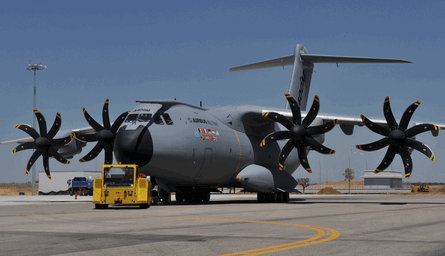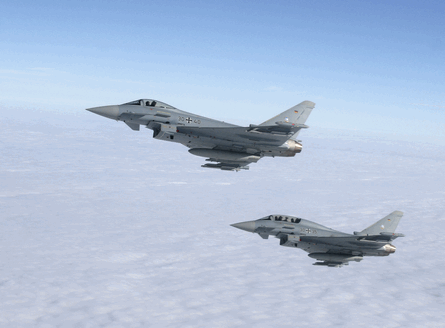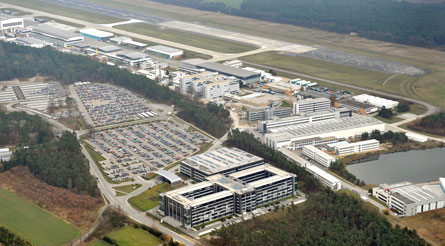EADS is marking the culmination of a three-year effort to rationalise its industrial footprint in southern Germany, with major investments in its Manching site near Munich intended to create a European centre of excellence for military maintenance, repair and overhaul activities.
The opening ceremony for EADS' Military Air Systems (MAS) centre on 17 November will be attended by senior company officials and German defence minister Franz Josef Jung. This milestone will celebrate the results of an approximately €100 million ($127 million) package of investments implemented since December 2005, when EADS announced a decision to end MAS activities at its Ottobrunn facility and harmonise military aircraft activities at nearby Manching. As a result 2,500 employees will move from the previous MAS headquarters by the end of this year, boosting the company's personnel levels at Manching to around 5,500. New infrastructure in place at the site includes two large office buildings and a support and engineering facility for the German air force's fleet of Panavia Tornado interdictor strike and electronic combat and reconnaissance aircraft.
 |
|---|
© EADS |
Manching was already the home for multiple activities, ranging from operational research to production and final assembly of the Eurofighter strike aircraft, and it was playing host to flight test services. The site also delivers in-service support and upgrades for fighter, transport (C160 Transall pictured, above) and special-mission aircraft EADS believes its expansion will lead to more widespread success in the MRO and systems integration sectors. "The efficiencies we can draw out of this development are enormous," says vice-president site management Peter Schwarz, who identifies the MRO sector as a particular area of interest. Forming part of EADS's Defence & Security division, the MAS unit generated e2.1 billion in 2007, with 36% of this drawn from its services business, which includes MRO and upgrade activities.
A major push is now under way to secure a deal to provide logistics support at Manching for the German air force's future fleet of 60 Airbus Military A400M transports, deliveries of which (below) had been expected from 2010.
 |
|---|
© EADS |
Germany's BWB procurement agency is currently considering a proposal from a joint venture comprising Airbus Military and EADS to support the Luftwaffe's A400Ms. This would use government-furnished equipment, primarily at the component level, rather than being implemented under an availability-based model. "Germany will decide in late 2008 or early 2009," says Schwarz.
Separately, EADS could in future offer A400M support services to other operators of the transport, deliveries of which have been delayed due to development problems, primarily involving its Europrop International TP400-D6 turboprop engines.
As a result of the delayed availability of its next generation airlifter the Luftwaffe is seeking a life-extension to some of its C160 Transall tactical transports, more than 80 of which are now in use. These visit Manching for inspections and modifications, such as the integration of self-protection equipment and countermeasures for operations in Afghanistan. However, by year-end the air force will transfer all depot-level maintenance of its C160s to Manching from Penzing air base.
A similar move is planned for Germany's Tornados, with depot-level maintenance shifting to the EADS site from Erding air base, along with 30 personnel. The Luftwaffe plans to continue operations with part of its Tornado fleet until between 2025 and 2030.
Moving in-service support of the Tornado to Manching will create efficiencies and will more closely mirror the Luftwaffe's arrangements for its Eurofighter interceptors (two pictured below), EADS says. System support centres (SUZ) for both types have been in place at the Bavarian site since 2002, respectively staffed by mixes of 100 and 170 industry and military personnel.
 |
|---|
© Eurofighter |
The Eurofighter SUZ provides maintenance oversight for the complete weapon system. It has a user helpdesk which delivers support and workaround suggestions for the Luftwaffe's operational and training squadrons at Neuburg/Donau and Rostock-Laage airbases. Additional tasks include maintaining software and training system engineers.
EADS and the air force also have a so-called Eurofighter Co-operation Airframe deal in place, which covers maintenance up to depot level, plus upgrade and retrofit, special inspection and system check work at Manching. The arrangement allows for special inspections, repairs to defects or structural damage, and even the recovery of damaged aircraft from the Luftwaffe's main operating bases.
Austria will also send its eventual fleet of 15 Eurofighter Typhoons to Manching to undergo major maintenance. "The consolidation of MAS activities makes Manching the centre for integrated solutions over the whole life cycle," says Berndt Wünsche, EADS senior vice-president, combat air systems.
Following its investment, EADS's footprint at Manching totals almost 90ha (222 acres), with the site also accommodating a military and governmental integration centre and the German air force's WTD-61 test unit. Schwarz says a further planned initiative is for EADS to establish a joint Eurofighter flight test centre with WTD-61, to deliver benefits in areas including logistics support.
Manching could also host support infrastructure for the Germany navy's future fleet of Eurohawk high-altitude, long-endurance unmanned air vehicles. These will be adapted from Northrop Grumman's RQ-4 Global Hawk under a partnership agreement with EADS. They will enter service as replacements for the navy's electronic intelligence-configured Dassault-Breguet ATL-1 Atlantics.
The navy's new fleet of eight Lockheed Martin P-3C Orion maritime patrol aircraft are already undergoing extensive work at Manching. Acquired secondhand from the Netherlands, the aircraft, which entered use in the early 1980s, have been discovered to be in worse condition than expected. "There are lots of cracks and corrosion to the wing and rear spar," says one EADS source, who describes the support challenge facing the navy as "a big nightmare".
 |
|---|
© Craig Hoyle/Flight International |
While the majority of aircraft supported at Manching are from the German armed forces, the largest type currently supported is NATO's Boeing E-3A Airborne Warning and Control System aircraft. EADS holds a long-term contract to maintain the alliance's 17-strong fleet each aircraft is required to undergo depot-level work lasting 10-11 months every six years.
EADS has already completed a mid-life upgrade to NATO's E-3As and is poised to start work to boost the type's self-protection capabilities. The first aircraft to receive Northrop's AAQ-24 large aircraft infrared countermeasures upgrade at Manching will enter work in mid-November.
With NATO now seeking to extend operations of its AWACS fleet until 2040, EADS has recently completed a study into a potential re-engining programme for the type. The company confirms that options for extending use of the Boeing 707-based surveillance system include installing "plug-and-play" replacements for the aircraft's four Pratt & Whitney TF33 turbofans, or a "part conversion of the wing" to accommodate new powerplants.
 |
|---|
© EADS |
The shift from Ottobrunn to Manching (above) has not been without its challenges, and EADS says it will take several years for the rationalisation process to be completed. But with its MRO business already expanding at the site and the potential to welcome new aircraft types within the next few years, the move already appears to be paying dividends. "Now Military Air Systems is ready to take over the leading role for military system integration and support in Europe," says Wünsche.
Source: Flight International























